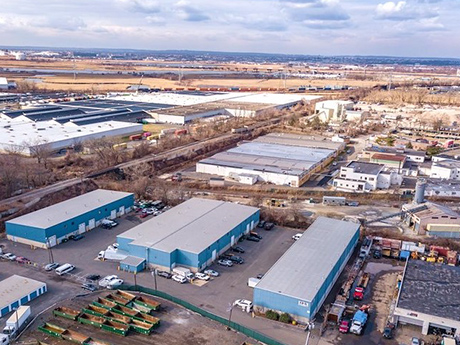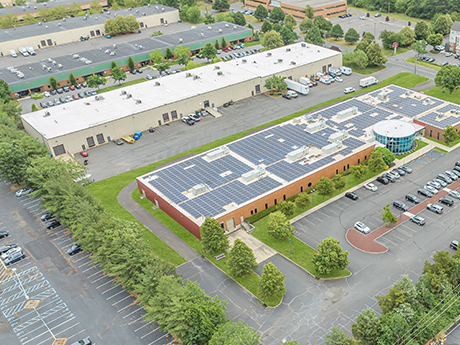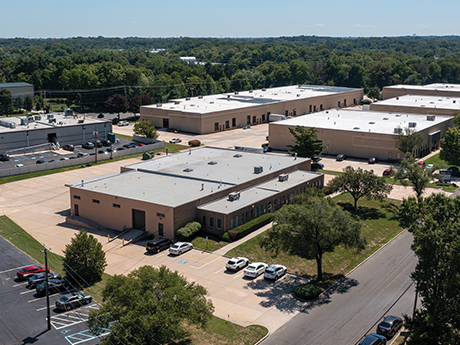By Taylor Williams
From an investment perspective, the New Jersey industrial market has plenty going for it: residential density throughout, proximity to major ports, high barriers to new development — but not even those fundamentals could shield the sector from macroeconomic variables that have caused deal volume and velocity to drop in recent years.
Given the benefit of hindsight, the decline in industrial investment sales activity between late 2022 and early 2024 is not really surprising. Like most major industrial markets, those of both Northern and Southern New Jersey saw explosive demand for space in the early months of the pandemic as Americans sheltered in place and did their shopping online. Rents soared to record highs; cap rates compressed to historic lows. Institutional capital planted its flag in the Class A trophy space, and investors of all types duked it out for everything else.
It was a hell of a party, but it couldn’t last. And when the lights began to come back on in the form of rising interest rates, sellers that didn’t have to sell generally chose not to.
“Cap rates leveled off with the pricing discovery that went on when interest rates started rising,” explains Marc Isdaner, vice chair at Colliers’ Southern New Jersey office. “Sellers weren’t adjusting to what buyers were looking for, which was distress, and sellers that didn’t have to sell because they weren’t getting their price simply didn’t do so.”
Buyers, particularly non-institutional ones, needed pricier debt to close. Less product made its way to market, and deals that were listed often stalled out as sellers hesitated to meet the market at recalibrated prices. Lack of comps complicated pricing, and the general investment sales landscape entered a sort of purgatory state.
“The conversation in 2023 was all about [interest] rates being higher and predictions on when they’d fall, and so transaction volume declined,” recalls Gary Gabriel, executive vice chair at Cushman & Wakefield’s Northern New Jersey office. “Sellers during that time were waiting for rates to go down so prices would come back, while buyers were waiting to see blood and buy accordingly on an opportunistic basis. So not much happened.”
According to second-quarter data from Colliers, the number of quarterly sales transactions in the New Jersey industrial market peaked at about 125 in the fourth quarter of 2021. Throughout 2022, the market saw between 60 and 90 closed deals per quarter. But volume dropped off sharply in 2023, not exceeding 40 transactions for any of the four quarters. Deal volume was even more muted in the first quarter of 2024, with fewer than 20 industrial sales closing, according to Colliers.
Jim McGuckin, regional manager at Marcus & Millichap’s New Jersey office, says that the drop-off in deal volume has been particularly pronounced at the institutional level, which he defines as deals that trade for a minimum of $10 million. These groups tend to have more hurdles to clear and red tape to navigate with their investment decisions but also possess greater depth of financial resources. Since rates began rising, institutional investment groups have generally adopted more conservative positions.
“In 2019, which is sort of a benchmark year in which rates were stable pre-pandemic, we had 124 transactions of $10 million or above in New Jersey,” McGuckin says. “In 2022, the peak year, there were 161 transactions — a 30 percent increase. In 2023, we had about half that and expect to remain flat this year as well.”
“So it’s an inventory story above all else; there’s just not a lot of available deals in New Jersey right now, especially in the institutional space,” he continues. “Not every listing sells, but with there being less inventory available, in turn less product sells, and that’s what we’re seeing in this market.”
Cushioning The Blow
For brokers, these market conditions can be quite challenging to navigate. According to McGuckin, the key is to always keep in mind that brokers are advisors above all else.
“Every market cycle has its own unique challenges, and as brokers, you have to be even-keeled and meet clients where they’re at,” he says. “When a client asks if it’s a good time to buy or sell, the answer is ‘it depends on the players involved.’ If certain owners have made money on the property and have a better opportunity, then it probably makes sense to sell. But for most owners that are cash flowing nicely and have strong tenants and getting the rents they want and don’t have external pressure in the form of a fund expiring or debt coming due, it probably makes more sense to hold and see what the future holds.”

Ultimately, however, these professionals in the New Jersey industrial space know that the inventory-for-sale problem is not unique to their asset class or market, and that strong underlying fundamentals will in due time restore healthy market dynamics.
“If you traffic in industrial in this region, there’s liquidity at all price points and for properties of all sizes,” says Gabriel. “With higher levels of macro uncertainty and more standing vacancy than at the market’s peak, investors are tending toward making smaller wagers rather than big, concentrated bets. But in this region, we’re blessed in that there’s not a lot that trades and not a lot that becomes available. And if it’s the right product, it will price aggressively at all [property] sizes.”
Gabriel also points out that as other asset classes, predominantly office, have faced challenges in their fundamental usage, more capital has come into the industrial space. This trend has accelerated the overall growth of industrial real estate as an investment asset class, which was already an impressive story unto itself.
“The additional liquidity provides a lot of shock absorbers; there’s always capital seeking entry into the space, which has provided downside protection from wild swings,” he says.
In addition, sources say that although the trifecta of unmotivated sellers, debt-strapped buyers and murky pricing parameters were instrumental to the slowdown in trades, there have been other contributing causes as well.
“What’s made [closing deals] more complicated is not just interest rates rising so sharply in 18 months, but also traditional lenders exiting the market and just not lending or not lending to normal standards,” explains McGuckin. “A lot of lenders have exited the market with full balance sheets and taken a wait-and-see approach and aren’t writing loans.”
“Other lenders have said that if they were [previously] willing to give 70 to 80 percent loan-to-value, that’s now 50 to 60 percent,” he continues. “That has forced buyers to come up with more equity per deal, which makes it that much more challenging in terms of getting deals done. If rates had increased the way they did but banks had been willing to lend at the same levels, the market probably wouldn’t have pumped the brakes the way it did.”
According to Isdaner, investors are also now less willing to consider deals at negative leverage than they were 18 months ago when rents were still trending toward record highs.
“The mentality of doing deals at negative leverage if properties have low WALTs still exists in some buyers’ minds, but only under perfect circumstances,” he explains. “It’s not just the rolling of the leases, but maybe the quality of the tenants that are rolling and what the local market conditions are.”
Negative leverage occurs when an investor buys a property at a cap rate that is below his or her all-in interest rate. While this scenario can create negative cash flows in the short run, it also allows investors to get their foot in the door when they might otherwise be priced out of a white-hot market. Properties in which the tenancy carries a low weighted average remaining lease term (WALT) are prime candidates for negative leverage deals, because when the leases expire, the new owner can lease the space up at higher rates, thus getting into the green on cash flows.
Isdaner notes that in Southern New Jersey, most of the inventory that’s traded over the past five years is multi-tenant infill product that doesn’t typically appeal to institutional buyers. As such, more regional and local owners have had opportunities to establish presences in the area, even if it meant doing so at negative leverage for a limited period of time if the upside justifies the cost.
“Most of the product here was under-rented and under-recognized, and that’s allowed more regional buyers to get into the market,” Isdaner confirms. “That product tends to be below the replacement cost [of building]. In that case, you can chase a little negative leverage if you’re under-rented and you know you’re buying below replacement costs because constructing multi-tenant buildings is extremely expensive.”
In Gabriel’s view, the rebound is already starting to take shape.
“Activity started picking back up in the spring of this year, at which point a confluence of two things happened,” he explains. “Sellers decided to meet the market because they’d waited for a year or two to sell and realized that it’s time to transact as a matter of our business. Then you had buyers that had raised a lot of money but put out very little — or none, as was the case with several institutional clients. Those groups are getting back to business, and there’s less conversation about interest rates and when cuts are coming, and there’s less of people waiting for that to happen [before transacting].”

After more than two years of painful-but-necessary rate hikes and holds, the Federal Reserve reversed course on Sept. 18, delivering a 50-basis-point cut to the federal funds rate. But brokers caution that the cut, the magnitude of which exceeded expectations of many of Wall Street’s movers and shakers, is not likely to usher in an immediate wave of new transactions.
“We’ll need six to 12 months to determine the impact of rate cuts,” says Isdaner. “For transactions that are being negotiated now — assuming a price has already been negotiated — that could be the difference in the buyer being able to get over the hump and the deal getting done. If buyers are realistic in their underwriting and patient, there are good tailwinds in the South Jersey industrial market and positive long-term trends.”
At least one investor feels the same.
“If we get rate cuts, there will still be a lag; debt and equity sources want to see that it’s a trend and not an anomaly,” says Dov Hertz, president of New York City-based DH Property Holdings. “Ultimately, if it’s a real trend and if rates come down, debt and equity [sources] will get back into the market, and development will start picking back up for all the reasons that kept those sources out of the market when interest rates were rising. The caveat would be if we get thrown into a recession.”
More Investor Input
Complex and challenging as market conditions have been for brokers over the past 18 months, one could argue that it’s been an even more stressful time to be an investor. After all, it’s their money that’s at stake if a property is overpaid or undersold.
But like the brokers who advise them, these buyers and sellers recognize that there are much worse places to be than New Jersey industrial.
“Regarding the market, we view Northern New Jersey as one of, if not the strongest industrial market [in the country],” says Albert Fitch, managing director at The STRO Cos., an investment firm based in Ridgewood. “Infill product, vacancy at historic lows relative to the past 10 years, rent growth that continues to improve year over year, strong absorption across the board, limited construction due to limited land to construct on — [for those reasons], we view New Jersey and its density as an irreplaceable location for industrial.”
The STRO Cos. most recently acquired a 76,560-square-foot industrial building in the Northern New Jersey community of Fairfield. The building, which was fully leased at the time of sale, houses small-bay units that range in size from 8,000 to 13,000 square feet and feature clear heights of 22 feet. The company, in partnership with KRE Group, is also redeveloping a former office building in nearby Florham Park into a 136,714-square-foot warehouse. That project speaks not only to the need for more industrial space but also the challenges that come with delivering new supply from the ground-up.
Fitch recognizes that these strong fundamentals have attracted more competition to the New Jersey industrial space. But that’s not necessarily a bad thing, in his view.
“The presence of institutional capital isn’t necessarily a downside to this market, but there are a lot of very confident investors that are looking at New Jersey for its strong fundamentals,” he explains. “For us, it just means we look harder for really good opportunities. This market over the past five years has had significant runup, and we’re now hitting a point in which there’s still room for growth, but it’s not the same as 2021-2022 when we had hyper rent growth due to there being such limited supply.”
Sources say that one fundamental metric that speaks to more opportunities coming to market is slowly beginning to manifest: the narrowing of the bid-ask spread.
“The bid-ask gap is narrowing, but we’re still not seeing a robust level of transactions,” says Hertz. “Sellers have various reasons they need to sell and can’t hold any longer while they’re waiting for interest rates to drop and cap rates to follow, which has forced some sellers to transact. It could be because it’s the end of a fund’s life or there are family situations that are the impetus for a sale. So we’re seeing some deals that have had those reasons for the sale, and as of late, the gap is narrowing.”
Hertz says that although he sees positive indicators like the narrowing of the bid-ask spread on the horizon, he’s still underwriting in-trended rents in the current market. In addition, given the lack of trades in recent months, he evaluates deals based on their perceived yield post-stabilization. Both philosophies reflect the more conservative nature that has come to characterize the market during the latest cycle.
“There’s no way to know what they’ll trend if they trend at all, which isn’t that different from a year ago, though maybe 18 months ago there was a bit more optimism in the market,” he says. “There’s guesswork involved with regard to what cap rates will be when a property stabilizes. But if we can underwrite today’s market rent based on market comps, and if it’s a relatively short WALT, then when the leases roll and space comes to market, we know what we can conservatively re-rent it at.”
As for other indicators, earlier this summer, DH Property Holdings acquired a 365,000-square-foot portfolio of shallow-bay industrial buildings in Southern New Jersey for $50 million. The portfolio included The Village of Pine Run, a six-building 235,000-square-foot park in Blackwood, and Cherry Hill Commerce Center, a four-building, 130,000-square-foot development. In commenting on the deal, Hertz noted that industrial tenancy in the region was “very sticky, with stellar renewal rates and continuously rising rents” for that product type.


